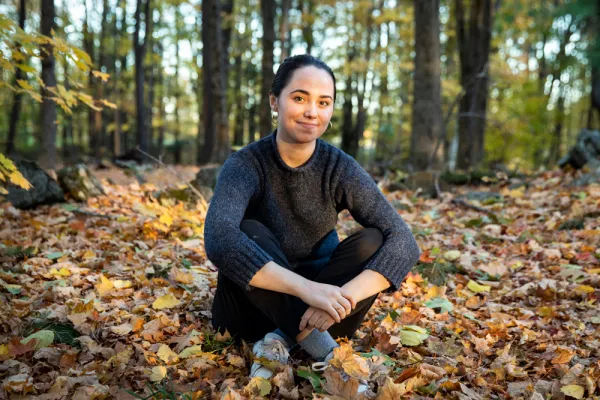Form, Function and Landscape Design
Campus Life

Published December 4, 2019
After a landscape design internship in Manhattan last summer, Tess Abbot ’20 has developed a keen appreciation for Smith’s winding pathways and bucolic gardens, the enduring influences of Frederick Law Olmsted’s vision for the Smith landscape. But as an aspiring designer, she also considers ways to improve how today’s students interact with it.
Abbot, an environmental science and policy major with a minor in landscape studies, initially intended to pursue studio art and biological sciences. That changed when, in her first year at Smith, she began interning at the 260-acre MacLeish Field Station in nearby Whately. She returned every year. Over time, she built a trail kiosk, a woodshed and an Adirondack lean-to, each of which helps her appreciate the way function influences form in the built and natural environment.
She thinks, for example, about the view of Paradise Pond from the sloping lawn near the boathouse. “This is Smith’s iconic view, but there are very few comfortable places to enjoy it,” Abbot said. “If I could change anything, I would create a space that welcomes more than just a manicured lawn; I would create more places for gathering that somehow feel more connected to campus history.”
MY FIRST TWO YEARS AT SMITH, I received funded research experiences through the AEMES Scholars Program (Achieving Excellence in Mathematics, Engineering and Sciences). My first project was to work with a faculty mentor, Reid Bertone-Johnson of the landscape studies department, developing a website to catalog artwork created at MacLeish. Eventually, I became the student manager for MacLeish and now work directly with field station manager Paul Wetzel.
“Some people see the landscape as something we simply move through, but with good design it can be much more than that.”
OVER MY SOPHOMORE SUMMER, I worked with two other Smith students to cut another mile of hiking trail on the eastern side of the MacLeish property. Working with my hands in this way helped me appreciate the importance of sustainable landscapes. Without AEMES, it’s likely I would not have explored all MacLeish has to offer or discovered a genuine interest in landscape design. This year, I am working on communication outreach and programming for MacLeish and mentoring seven interns who will work on projects like preparing new signage along some of the hiking trails.
MY FIRST PROFESSIONAL EXPERIENCE, an internship last summer at Mathews Nielsen Landscape Architects (MNLA), was partially funded by a Praxis stipend. I spent 12 weeks at work in lower Manhattan and was thrilled to be assigned hands-on projects. Signe Nielsen ’72, a founding principal of MNLA, encouraged my participation in client meetings and visiting project sites. Some of my work included logging plant health for a site designed along the East River Esplanade and measuring safe fall zones during the construction of a new school playground.
MNLA IS ALSO LEADING THE DEVELOPMENT of a new landscape master plan for Smith. The goal is to reenvision an overarching philosophy for the campus landscape. I am a student member of the Landscape Master Planning Committee, where we discuss how a sustainable landscape better aligns with Smith’s core values by addressing issues of inclusivity, education and adaptation.
SOME PEOPLE SEE THE LANDSCAPE as something we simply move through, but with good design it can be much more than that. Landscapes can foster community, promote an appreciation for the natural world and create resilience in the face of climate change. These are big issues that I am excited to address at Smith and beyond.
This story appears in the Winter 2019-20 issue of the Smith Alumnae Quarterly.
Photograph by Jessica Scranton